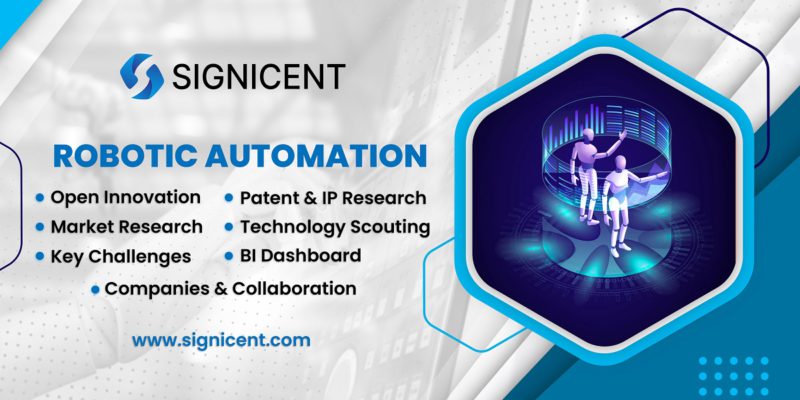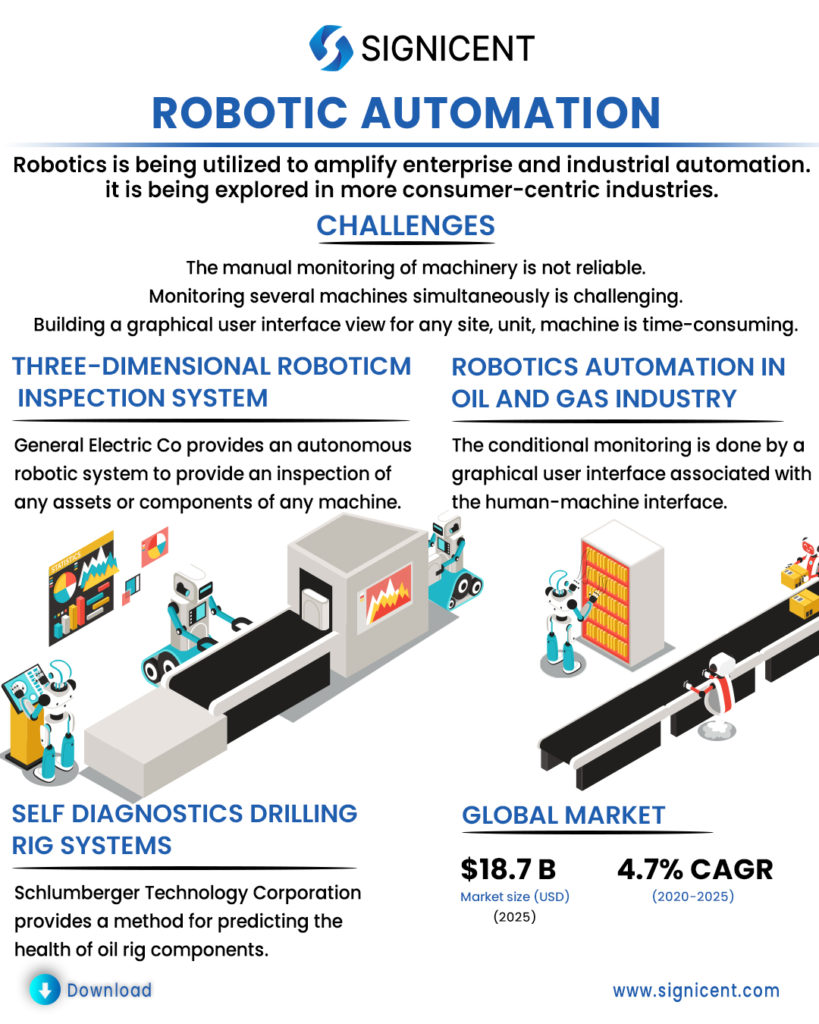A whitespace analysis, technology assessment, and market trends under the domain of robotics and human-machine interface (HMI) associated with oil and gas industry applications have been summarized in this report. The robotics automation report will shed light on emerging technology, scientific references, innovation trends, and Market Trends. Competitive intelligence (Key-players, start-ups, M&A) have been discussed.
Robotics is being utilized to amplify enterprise and industrial automation. Moreover, robotic automation is being explored in more consumer-centric industries. However, many consumer applications are more focused on the lifestyle-oriented industry but steadily its use is being adopted both in land-based and aerial repetitive, tedious, and/or risk-oriented tasks.
Condition Monitoring System
In this section of the Robotics Automation Report, the technology constraints are discussed to find out innovative solutions. It is anticipated that the adoption and usage will incline drastically with improvements in artificial intelligence, robotics and, cloud computing.
The manual monitoring of machinery is not reliable. Also, monitoring several machines simultaneously was a challenging task. Building a graphical user interface view for any site, unit, machine and sub-system was a time-consuming process.
Robotics Automation In Oil and Gas Industry
The R&D group of Baker Hughes Oilfield Operations LLC provides a conditioning monitoring system for industrial machines. The conditional monitoring is done by a graphical user interface associated with the human-machine interface. The conditional monitoring system provides a variety of tools for the identification and diagnosis of machine faults. By using conditional monitoring system the graphical user interface creation is improved. For instance, all configuration information for a machine displayed in the existing GUI, including measurement points, can be copied to a new GUI, associated with a different portion of the industrial environment.
Components of Conditional Monitoring System
A communication medium, a processor, a memory or data storage and input/output port, GUI. The GUI has the following features-
- Component option- machines, condition monitoring devices
- Primary display options- plots, status, case history
- Secondary display options- bar graph and chart
Condition Monitoring Mechanism
A user can select a machine or condition monitoring device from the component option, and then select the view from primary display options and secondary display options. Further, the components of the machine appear in the dynamic view space in a hierarchical form.
The selection procedure follows the following steps-
- Selection of process system from the plurality of process system displayed in the GUI.
- Selection of machines associated with the processing system.
- Selection of machine components associated with the machine.
Data entries: After the selection of the machine component, the GUI provides a visualization display. The visualization display shows data associated with the machine component. Further, the visualization display includes a data field option in which a user can enter real-time measurement data of various sensors.
New GUI Creation: A user can create a new GUI by simply copying all configuration information for a machine displayed in the existing GUI, including measurement points to a new GUI, associated with a different portion of the industrial environment.
Three-Dimensional Robotic Inspection System
In this section of the Robotics Automation Report challenges and emerging technologies associated with inspection have been discussed.
Traditional Challenge: It is difficult for an individual to inspect any assets or components of a machine in harsh environmental/industrial conditions e.g. in oil/gas industries, the inspection of the near high-temperature system is challenging.
Innovative Solution: The R&D group of General Electric Co provides an autonomous robotic system. The autonomous robotic system has the significance to provide an inspection of any assets or components of any machine. The inspection is carried out by an unmanned robot such as a drone. The unmanned robot travels to the asset. Then it monitors and analyzes the status of the asset by capturing a plurality of image data. The unmanned robot moves autonomously in both lateral and vertical directions concerning the asset based on a three-dimensional model of a travel path.
The 3-D model of the travel path is generated virtually based on a virtual asset corresponding to the physical or real asset. The robot has imaging and sensing capabilities and is capable of autonomous or semi-autonomous movement. Further, the robot may be an unmanned aircraft vehicle (UAV) such as a drone, or other types of the robot (e.g., crawler, roller, walker, autonomous underwater vehicle (AUV), etc.)
Key Benefits Offered
- Monitors and manage the desired conditions of an asset for eliminating human interventions.
- It helps in the generation of a 3D- model of the travel path.
Self Diagnostics Drilling Rig Systems
In this section of the Robotics Automation Report difficulties faced in the deliberation of the oil and gas production unit have been discussed. There are confined ways to recognize the operational status of the various pieces of equipment employed at a drilling rig.
The R&D group of Schlumberger Technology Corporation provides a method for predicting the health of oil rig components. The method includes the classification step of the components along with a system for deriving a numerical health index for the specific component.
The method identifies the conditions for the operation of the component by accessing a database of Health Index information as per the classification. The method further identifies a time at which the Health Index for the component will reach a predetermined threshold according to the Health Index information and the initial Health Index value.
Key Benefits Offered: The potential application of the invention is the ability to predict how certain activities, actions, jobs, etc. for the equipment will affect the health index of the equipment.
Key Players In Robotics Automation
In this section of the Robotics Automation Repor key companies that are aggressively working in robotics, automation has been discussed.
Kuka was established in 1898 with its headquarter in Augsburg, Germany. It is working on automated guided vehicles, industrial robotics, service robotics, automation, software, controllers, palletizing, medical Robotics, and the automotive industry.
Yaskawa was established in 1915 with its headquarter in Fukuoka, Japan. It is working on the motion controller, industrial robots, AC drivers, CNC controller systems.
Rockwell Automation was established in 1903 with its headquarter in Milwaukee, U.S. The company works on Graphic Terminals, Tethered Operator Terminals, Industrial computers, and monitors.
Yokogawa was established in 1915 with its headquarter in Tokyo, Japan. The company works in the distributed control system, sensors, and controllers for monitoring and operating digital oil and gas fields.
Each year Signicent provides consultancy to hundreds of organizations to help transform their innovations to value.
Merger & Acquisition
Rockwell Automation founded in 1903 is a global leader in industrial automation and digital transformation. Rockwell Automation covers control systems, industrial control components, information software, motor control devices, sensing devices, network technology, safety technology, and industrial security. The Headquarters are in Milwaukee, U.S.
ASEM provides a complete range of industrial PCs (IPCs), human-machine interface (HMI) hardware and software, remote access capabilities, and secure industrial IoT gateway solutions. The headquarter is located in Italy. It was founded in 1979.
In May 2020, Rockwell Automation acquired ASEM, S.p.A. to further enhance the Control & Visualization hardware and software portfolio. ASEM is primarily a supplier to European machine builders with great opportunities in the North American market. Allow them to achieve faster time to market, lower their cost of ownership, improve asset utilization, and better manage enterprise risk.
Recent Commercialized Products
VersaView 6300M Industrial Monitor
Rockwell Automation introduces a special industrial monitor for monitor and controlling processes and machinery. The VersaView 6300M provides up to full high definition (FHD) resolution with a 16 million colors LED backlight display in different sizes and aspect ratios from 10.1” to 24”. The VersaView 6300M industrial monitor includes a ten-point multitouch screen that can also be operated with gloves.
Global Market Trends
In this section of the Robotics Automation Report, the global market size and trends have been discussed.
The global market of automation in the oil and gas industry is projected to grow from an estimated USD 14.9 billion in 2020 to USD 18.7 billion by 2025, at a CAGR of 4.7%. The growth of the industrial automation oil & gas market is driven by IIoT adding value in the automation and optimum and effective exploration of aging reservoirs.
Industry 4.0 is an integration of cyber-physical systems, IoT, and cloud computing. It consists of an industrial automation infrastructure and IoT, which enables operators to carry out processes at a refinery remotely, and the real-time information is collected intelligently to be used by the industry to operate on an optimum basis. By Geography, the market is segmented into North America, APAC, and Europe.
In APAC, the deployment of industrial automation oil & gas and solutions is expected to increase rapidly during the forecast period in China, India, and Malaysia. The market in APAC is growing rapidly owing to the large-scale advancements and technological innovations in the oil & gas industry; this necessitates the use of industrial automation in oil & gas solutions and components.
COVID-19 has been spreading across the world, starting from APAC, then moving to Europe, and currently accelerating in North America. Globalization and interconnected economies of most countries would be affected due to COVID-19. Due to the imposition of lockdowns across different countries, companies are facing severe cash flow issues. Halting or slowing down of manufacturing of industrial automation oil & gas, as well as disruptions in the supply chain logistics globally owing to the outbreak of COVID-19, have resulted in reduced demand for industrial automation oil & gas.

